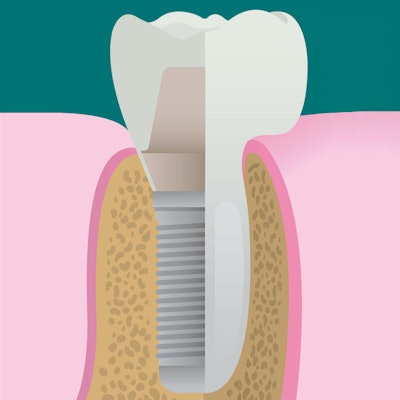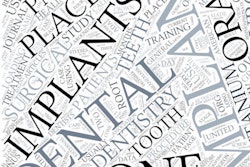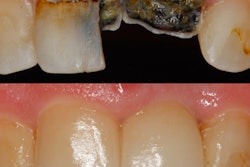
Is computer-guided implant placement actually better than conventional implant procedures? Are guided protocols preferred for certain situations? While the technology certainly offers significant promise, a new study investigated whether current scientific evidence backs it up.
The researchers examined high-quality published findings that compared the clinical advantages and disadvantages of guided implant and conventional treatment protocols. They found that the results were limited and demonstrated no clear differences in outcomes between the two, and the team published their findings in BMC Oral Health (December 13, 2017).
"There are clinical situations in which guided surgery protocols can have greater advantages, but to date the literature does not yet show what they are," lead study author Marco Colombo, DDS, a private practitioner in Milan, Italy, told DrBicuspid.com.
Evidence finds similar results
Guided implant protocols may help dentists simplify their procedures, the authors noted. Advantages include performing minimally invasive surgery and having a prefabricated fixed prosthesis available for immediate implant loading. However, among the disadvantages are incurring a learning period for the dentist, technician, and entire dental team; greater time needed for presurgical planning; and financial investment in new technology and equipment.
“There are clinical situations in which guided surgery protocols can have greater advantages, but to date the literature does not yet show what they are.”
Because of the large number of such protocols and their rapid evolution, the published literature often does not provide accurate information on the advantages and disadvantages for clinicians or patients of guided implant surgery, often focusing on just specific aspects, the authors wrote.
Therefore, they conducted the current study to evaluate high-quality evidence in the form of randomized controlled trials that compared guided implant surgery with conventional implant placement protocols.
This study and three others represent the work of the first closed meeting of the Digital Dentistry Society in Milan in September 2016, Dr. Colombo noted. Among the organization's objectives is creating guidelines to help clinicians use digital dentistry tools. The researchers also sought to provide scientific information regarding which clinical situations are best managed with guided implant protocols.
They searched the Medline database for randomized controlled studies that compared digital workflow for oral implant placement with conventional procedures in the alveolar crest and had the following additional characteristics:
- At least five patients in each group
- Follow-up of at least six months after loading
- Presence of clinical, radiographic, patient-centered outcomes or economic evaluations.
After careful evaluation of various articles, the researchers found only two studies that complied with all inclusion criteria and included them in the current review. Both studies compared implant placement with 3D planning and dedicated digital guide with freehand conventional placement, as well as evaluated prosthesis failure, implant failure, and biological or prosthetic complications.
At one year from final loading, one of the studies found similar results in both groups, with none of the 314 implants among 59 patients lost. The two groups had no significant differences in bleeding, pocket probing depth, peri-implant marginal bone loss, or quality of life. However, the authors of the current study judged that paper to have a high degree of risk of bias in the randomization process.
In the other study, after one year after prosthetic placement in 51 fully or partially edentulous patients, the two groups had no statistically significant differences in implant failures, complications, peri-implant bone loss, or patient satisfaction. However, the patients treated with conventional procedures reported significantly more postoperative pain (p = 0.002) and swelling (p = 0.024) compared with patients who underwent guided implant surgery.
Surgical time was similar between the groups, although the guided surgery group had more cases that were considered complex. Additionally, evaluation of outcomes was not blinded.
"Unfortunately, the results obtained have confirmed the important lack of scientific literature that can demonstrate or deny the advantages of guided surgery compared to conventional protocols," Dr. Colombo told DrBicuspid.com.
He added that many of the articles he and his colleagues analyzed for potential inclusion in the current study had a medium-low level of scientific rigor. Nevertheless, their study did demonstrate some positive attributes of guided implant surgery.
High-quality research needed
Dr. Colombo and his colleagues would like to be able to give clinicians more information about which types of implant situations should be managed with guided protocols. However, the current study was not able to provide these data.
They plan to regularly evaluate articles published in the future on guided surgery to add to the review process started with the current study and develop guidelines for guided protocols, according to Dr. Colombo.
"My opinion, and that of the other authors of this article, is that guided surgery can be applied to all cases of implant surgery," he told DrBicuspid.com.
Dr. Colombo noted that the following situations may achieve greater benefits from guided surgery:
- Implant-supported rehabilitation of completely edentulous arches with immediate-loading protocols
- Implant placement in areas with low bone volume
- Rehabilitation of areas with high aesthetic value
However, he emphasized that these are only opinions without clear scientific support.
"From our study, it is clear that implant-guided surgery has a good degree of safety and several advantages," he concluded. "This must be balanced by the higher costs and skills that the clinician must acquire in order to perform these procedures."



















